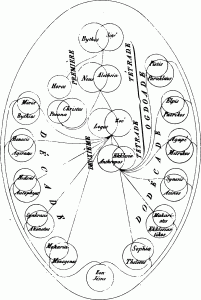Early Egyptian Christianity had a strong non-orthodox strand, if that “Gnostic” current did not actually dominate. I have already discussed the influence of Basilides, but Egypt produced an even more celebrated teacher in Valentinus. What makes him so interesting for a modern Christian audience is that he shows just how close the Gnostics were to a mainstream faith, while being so radically distant in fundamental assumptions. It’s like seeing a familiar picture through a distorting mirror.
Valentinus was an Egyptian who came to Rome in the mid-130s, and taught there through about160. Even his deadliest enemies admired his talents. Tertullian called him “an able man both in genius and eloquence.” Reputedly, he was even a serious candidate for the Roman bishopric, but was defeated.
Like Basilides, he taught a Creation myth of descending orders of perfection. Below the absolute deity, Bythos (Depth) there was a sequence of Aeons, each with its pair, forming a syzygy (Depth/Silence, Mind/Truth, Logos/Life, Man/Church). Fifteen syzygies made thirty Aeons, and together they comprise the Fullness, Pleroma, the spiritual universe.
Incidentally, that is useful to know when reading present or future claims about strange gospel finds suggesting that Jesus had a sexual relationship with some woman, usually Mary Magdalene. Of course, a Valentinian or Gnostic would know that Jesus must have a partner to form a male-female syzygy, and the relationship is easily expressed in sexual analogies. Only a gullible modern would claim that such a symbolic passage must reflect a historical reality.
The blunder of one of the Aeons, Sophia (Wisdom) led to the creation of the inferior material world, with its ignorant deity, the God of this world. Christ, an Aeon, came to liberate human beings, who represent a blend of spiritual substance trapped in dark matter. As for Basilides, this Christ was a cosmic power, who descended on Jesus at his baptism, and left near his bodily death, perhaps during his interrogation by Pilate.
In modern times, the rediscovery of the Nag Hammadi library has vastly expanded our knowledge of the Valentinians, as eight of the works represented are considered to belong to that movement. In particular, the Gospel of Truth allows us to read Valentinus’s interpretation of the role of Christ, perhaps in the teacher’s own words:
The gospel of truth is joy to those who have received from the Father of truth the gift of knowing him by the power of the Logos, who has come from the Pleroma and who is in the thought and the mind of the Father; he it is who is called “the Savior,” since that is the name of the work which he must do for the redemption of those who have not known the Father….
That is the gospel of him whom they seek, which he has revealed to the perfect through the mercies of the Father as the hidden mystery, Jesus the Christ. Through him he enlightened those who were in darkness because of forgetfulness. He enlightened them and gave them a path. And that path is the truth that he taught them. For this reason error was angry with him, so it persecuted him. It was distressed by him, so it made him powerless. He was nailed to a cross. He became a fruit of the knowledge of the Father.
(I am using Robert Grant’s translation).
It’s hard for non-specialists to pay much attention to the obsessive account of the Pleroma, but the Gospel of Truth is often much more comprehensible. In its evocations of something like the canonical Epistles of John, it can be quite powerful. If not actually orthodox Christianity, it teaches a system that is not too far removed from it. It imagines a flawed world wandering in error, terror, and oblivion, into which comes a redeemer from the world of Light, to teach the words of the Father. Christ came to remind us of our spiritual home, to wake us from sleep, ignorance and separation.
Also strangely familiar is the doctrine of predestination found here:
Those whose name he knew in advance were called at the end, so that one who has knowledge is the one whose name the Father has uttered. For he whose name has not been spoken is ignorant. Indeed, how is one to hear, if his name has not been called?
Like Basilides, Valentinus placed himself firmly in the Christian tradition. He claimed a secret revelation handed on from Theudas, who reputedly had received secret teachings from Paul himself. Valentinus also rooted himself in the New Testament. Remember those thirty mysterious Aeons? Well, he found them clearly described in the gospel. As Irenaeus reported:
They maintain also, that these thirty Aeons are most plainly indicated in the parable of the laborers sent into the vineyard. For some are sent about the first hour, others about the third hour, others about the sixth hour, others about the ninth hour, and others about the eleventh hour. Now, if we add up the numbers of the hours here mentioned, the sum total will be thirty: for one, three, six, nine, and eleven, when added together, form thirty.
However strange this seems, it’s very much in keeping with the highly allegorical style of Bible interpretation that was already an Alexandrian specialty, and which would reach dizzying new heights in the next century with Origen.













